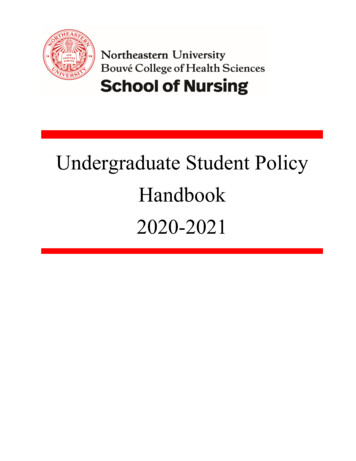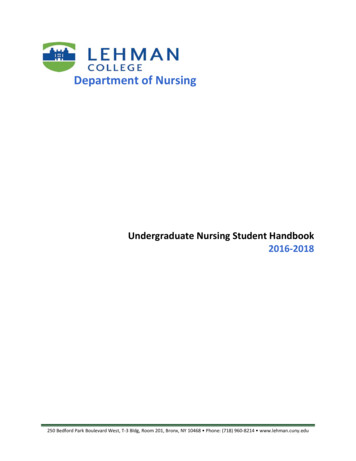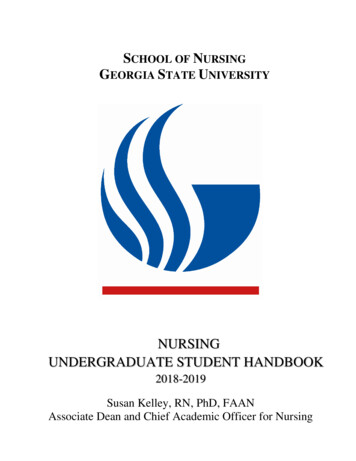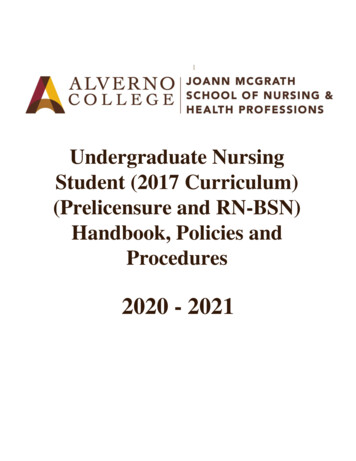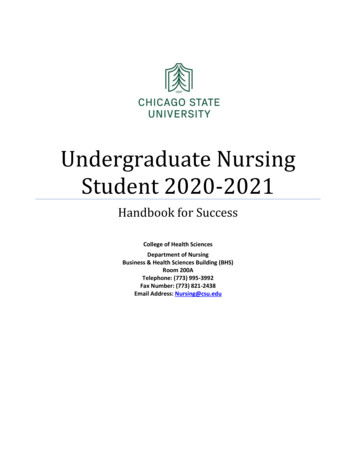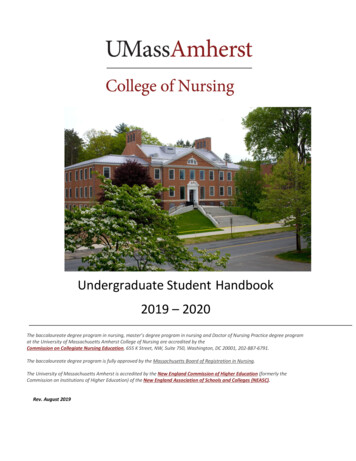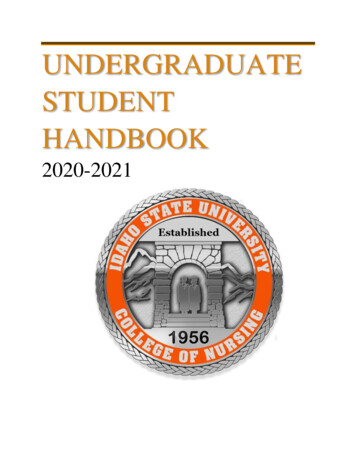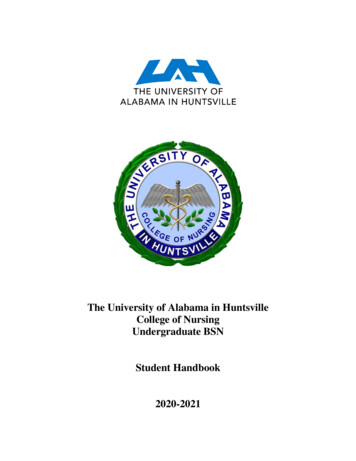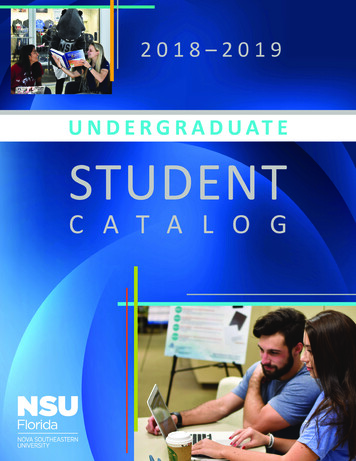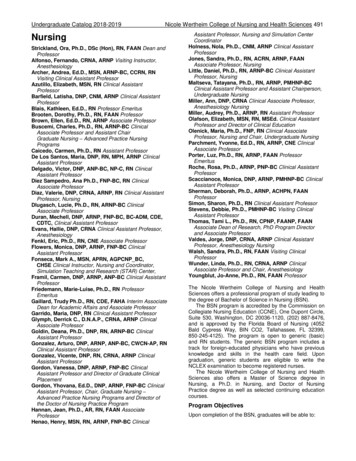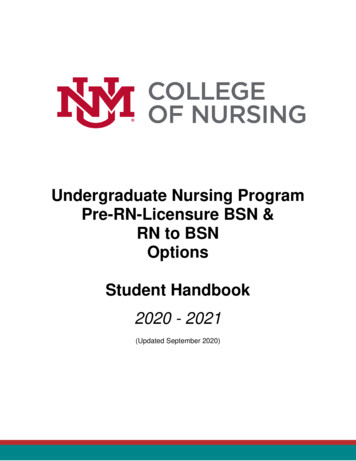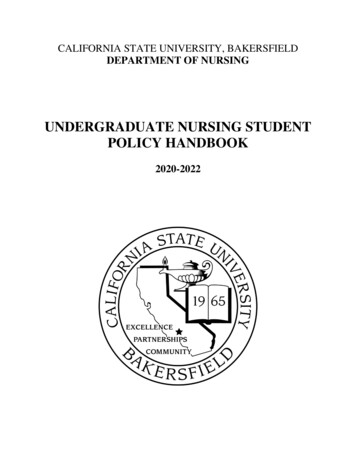
Transcription
CALIFORNIA STATE UNIVERSITY, BAKERSFIELDDEPARTMENT OF NURSINGUNDERGRADUATE NURSING STUDENTPOLICY HANDBOOK2020-2022
ContentsSection I.Overview of the Department and Program .1A.B.C.D.E.F.G.H.I.J.K.L.M.N.O.P.Q.Introduction .2Overview of the Department of Nursing .2California State University, Bakersfield Mission Statement.4Department of Nursing Mission, Vision, and Values .4Goals of the Department of Nursing .5Strengths, Weaknesses, Opportunities, and Threats.7Philosophy of Nursing .8Philosophy of the Teaching Learning Process and Professional Education .10Development of Concepts in the Curriculum .11CSUB Conceptual Model .13Conceptual Model: Definitions .13Major Strands of the CSUB Undergraduate Curriculum .16Alignment of Strands with BRN Requirements and AACN Essentials .18References .18Alignment of Baccalaureate Program and Level Objectives .20Faculty Organization Bylaws .22Organizational Charts .31Section II.Admission and Progression Policies .38A.B.C.D.E.F.G.H.I.J.K.L.M.N.O.P.Q.Admission .39Admission Health and Safety Requirements .52Annual Health and Safety Requirements .54CSUB Clinical Facility Orientation Form .55CDC/ACIP Recommendations .56Policy for Students with Disabilities or Limitations .57Essential Functions: Physical & Mental Qualifications .58Sample Physician’s Statement Form .61Progression Policy .62Policy Statement for Clinical Refresher (N2771, N3771, N4771).64Grading Policy .64Grading Scale Policies and Procedures .65Priority for Enrollment in Nursing Courses .65Clinical Section Reassignment .65Withdrawal from the Nursing Program or University.66Assignment of a Grade of “Incomplete” .66Currency of Courses Policy .67Section III.A.B.C.D.Student Responsibilities .68Ethical Standards .69Code of Academic Conduct .71Guidelines for Professional Appearance .75Classroom Behavior, Email Etiquette, & Testing Policy .78ii
E.F.G.H.I.J.K.L.M.N.O.P.Q.R.S.T.U.Section IV.A.Section V.Attendance Policy.81Transportation .82Simulation Center & Skills Laboratory Rules .83Policy for Students Practicing Procedures on Each Other .84Syringe Disposal Policy .85Clinical Section Reassignment .85Priorities for Clinical Rotation Assignments.85Policy for the Process of Evaluation of Students in Clinical .86Clinical Remediation Policy .87Student Safety in the Clinical Setting.89Nursing Computer Lab Guidelines.90Mailbox Security Policy .90Student Representation on Departmental Committees .90Student Feedback .91Lines of Communication .91Policy for Written Work .91Policy on APA Publication Manual .92Disciplinary & Related Policies .94Academic Integrity Violation Process .95Support Services/Student Organizations .103A.Financial Aid .104B.Special Scholarships Awarded by the Recruitment, Outreach, Scholarship, andAwards (ROSA) Committee .104C.Support Services and Resources.105D.California Nursing Student Association (CNSA) .105Section VI.RN-BSN Program Handbook . Addendum Aiii
Section I. Overview of the Department and Program1
A.IntroductionCalifornia State University Bakersfield (CSUB) opened in September 1970 as the 19th member of the23-campus CSU system. Its vision is to become the leading campus in the CSU system in terms of facultyand academic excellence and diversity, quality of the student experience and community engagement.CSUB is located at the southern end of the San Joaquin Valley approximately 110 miles north of LosAngeles. As the only four-year institution within a 100-mile radius, CSUB is located in the city ofBakersfield, a commercial, medical, and educational center for the area. The university serves a regionalpopulation of over 900,000 including the city and unincorporated areas. The campus, located on a 375acre site that was donated from the private sector, sits on the growing western edge of metropolitanBakersfield. Thirty buildings provide classroom, laboratory, administrative, and technical supportfacilities. Enrollment in the university for Fall 2020 included 9,788 undergraduate and 1,609postgraduate students, served by over 1,200 faculty and staff members. CSUB has 45 bachelor’s degreeprograms, 6 credential programs, 21 master’s degree programs, and a doctoral program in education.The university is fully accredited by the Western Association of Schools and Colleges, Senior Collegeand University Commission (WSCUC, formerly known as WASC), with six programs also accreditedby national organizations. Accreditation by WSCUC was reaffirmed in 2020 and the university’s nextcomprehensive review will be held in 2027.CSUB is a comprehensive regional University and is committed to excellence in its four schools: Artsand Humanities, Business and Public Administration, Natural Sciences, Mathematics and Engineering(NSME), and Social Sciences and Education. The Department of Nursing (DON) is one of eightdepartments in the School of NSME.B.Overview of the Department of NursingUndergraduate ProgramOver the past 50 years, more than 2,750 students have earned a BSN through CSUB’s two undergraduatenursing programs. Non-licensed students can obtain a BSN and eligibility for permission to take theNational Council Licensure Examination (NCLEX-RN) through the Traditional BSN Program, arigorous 3-year experience. Registered nurses can earn a bachelor’s degree through the RN-BSNProgram, which features online didactic courses and a face-to-face clinical course in Community HealthNursing.As of January 2021, there are 174 Traditional BSN students and 49 RN-BSN students enrolled at CSUB.As a result of heavy demand, the Traditional BSN Program and the RN-BSN Program have both beengranted Impacted Status designation from the CSU Chancellor’s Office (Exhibit A). In the CSU system,a program is granted Impacted Status when the number of applications received exceeds programcapacity. At CSUB, admissions standards and ranking criteria for the Traditional BSN and RN-BSNPrograms are established by the Undergraduate Program Committee (UPC), and cohorts are comprisedof the top-ranking candidates. Graduates of the Traditional BSN and RN-BSN Programs have providedan excellent pool of candidates for admission to the Master of Science in Nursing (MSN) Program atCSUB.2
Graduate ProgramThe DON opened the MSN Program in 1987 with a graduate degree in Nursing Administration andsecured National League for Nursing (NLN) accreditation in 1991. After the implementation of theFamily Nurse Practitioner (FNP) Track in 1996, the BSN and MSN programs transitioned successfullyto accreditation by the Commission on Collegiate Nursing Education (CCNE) in 1998. Additional MSNtracks were also introduced and discontinued over the years, based on student demand and availableresources. Between 1990 and 2010, the MSN program graduated 114 FNPs and 87 Clinical NurseLeaders, Clinical Nurse Specialists, Nurse Educators, and School Nurses. Most MSN graduates haveremained in Kern County and are leaders within the local healthcare community.During a period of economic recession and statewide budget cuts in higher education, the difficultdecision was made to temporarily close the MSN Program in 2010. Between 2010 and 2014, leaderswithin the community and on campus monitored the trends within the healthcare system, thecommunity’s needs, and the professional goals of current and prospective students. A feasibility studywas conducted, which indicated a tremendous need for more FNPs; a healthy MSN/FNP Program is acritical resource for the Central Valley of California. Through the dedication and expertise of the DONfaculty, the MSN/FNP Program was reopened in Fall 2014.Cohorts were accepted to the MSN Program on an every-other-year basis until Fall 2019, when annualadmissions were initiated. As of January 2021, there are 19 first-year and 18 second-year studentsenrolled, for a total of 37 graduate students. The MSN/FNP Program requires five semesters of full-timecoursework, including 585 hours of clinical practice. Since reopening in 2014, the program has graduated50 well-prepared FNPs.In accordance with the commitment by the National Organization of Nurse Practitioner Faculties(NONPF) to establish a doctorate as the entry-level degree for NP practice by 2025, the DON hasinitiated the process to develop a Doctor of Nursing Practice (DNP)/Nurse Practitioner (NP) degree atCSUB. The university Provost and President, as well as the Academic Senate, have approved placementof the DNP on the Academic Master Plan for CSUB, verifying that the necessary support for this criticaltransition has been secured.Nursing FacultyThe Department’s nursing faculty are highly qualified nurse scholars and educators prepared in researchand practice of their respective nursing disciplines. Faculty members meet the California Board ofRegistered Nursing expectations for clinical competence, the University and the Commission onCollegiate Nursing Education’s expectations for scholarship, teaching, practice and leadership.ResourcesThe Department maintains three technical areas for nursing students in the Romberg Nursing EducationCenter (RNEC) on the CSUB campus: a nursing skills laboratory, a computer laboratory, and the DonC. and Diane S. Lake Family Simulation Center which contains low, medium, and high-fidelitymannequins and skills trainers. Additionally, the simulation center has an attached smart classroom tosupport multiple forms of technology-assisted classroom instruction. The nursing skills laboratory has13 patient care learning stations, and the computer lab contains PC and Macintosh computers,instructional software, and multimedia resources.3
Community PartnersStudents practice their nursing skills at many locations in Bakersfield and in the surrounding KernCountry area. These facilities include hospitals, physicians’ offices, health clinics, schools, public healthagencies, homeless shelters, hospices, and specialty care centers.CSUB Non-Discrimination and Non-Harassment PolicyThe Department of Nursing follows the CSUB policy on non-discrimination and non-harassment anddoes not discriminate on the basis of race, religion, sex, age, handicap, color, marital status, sexual ornational origin.The CSUB Policies can be found at the following site:http://www.csub.edu/bas/hr/hr policies procedures/C.California State University, Bakersfield Mission StatementCalifornia State University, Bakersfield is a comprehensive public university committed to offeringexcellent undergraduate and graduate programs that advance the intellectual and personal developmentof its students. An emphasis on student learning is enhanced by a commitment to scholarship, diversity,service, global awareness and life-long learning. The University collaborates with partners in thecommunity to increase the region's overall educational attainment, enhance its quality of life, and supportits economic development.D.Department of Nursing Mission, Vision, and ValuesMissionThe Department of Nursing provides nursing education to undergraduate and graduate students seekingentry into professional nursing or advanced nursing education. The faculty provides a collaborative,inclusive, and interactive learning environment committed to excellence in teaching, scholarship,service, and practice. The Department of Nursing accomplishes the mission through collaboration withthe communities of interest.The Department of Nursing fosters an environment that encourages lifelong learning and advancementwithin the profession. Graduates will have the acquired knowledge, skills, attitudes, and values essentialto the practice of advanced professional nursing. As professional nurses, our graduates will engage inevidence-based practice in an interprofessional healthcare environment. In recognition of the healthneeds of a multicultural society, advanced professional nurses who are graduates of CSUB will addresshealthcare issues and needs of their community.VisionThe CSUB Department of Nursing pursues innovative ways to advance nursing practice and address thegrowing complexities associated with creating a healthier population in California’s Central Valley.ValuesThe Department’s values align with those of the university, including academic excellence, freedom ofinquiry and statement, global awareness and cultural sensitivity, diversity, honesty and fairness,democratic governance, community engagement, and personal responsibility. The DON embracesprofessionalism and a respect for the inherent ethical values of altruism, autonomy, human dignity,integrity, and social justice as fundamental to the discipline of nursing.Revised 03/12; 01/14; 12/15; 03/16; 2/21 by UPC4
E.Goals of the Department of NursingThe DON goals reflect professional nursing standards. These standards are provided in the followingdocuments, which serve as a foundation for the curricula and policies of the DON:1)2)3)4)5)6)7)Standards for Accreditation of Baccalaureate and Graduate Nursing Programs (CCNE, 2018)The Essentials of Baccalaureate Education for Professional Nursing Practice (AACN, 2008)Quality and Safety Education for Nurses: Prelicensure Competency KSAs (QSEN, 2007)Code of Ethics for Nurses with Interpretive Statements (ANA, 2015)Nursing’s Social Policy Statement: The Essence of the Profession (ANA, 2010)Nursing: Scope and Standards of Practice (ANA, 2015)California Code of Regulations (CCR) pertaining to nursing education (California BRN,regularly updated)Based on the statements in the philosophy, the overall goal of the Department of Nursing is thecontinuing development and preparation for graduation of individuals who will provide professionalnursing through clinical practice, leadership, research and education.Strategic Goals and Objectives of the DONThe following major objectives and key strategies will be achieved by the Department of Nursing over the next 5years:The following major objectives and key strategies will be achieved by the Department of Nursing overthe next 5 years:1. Demonstrate student outcomes that reflect program excellence through ongoing and consistentProgram Evaluation to determine efficiency and effectiveness.a. Expand the capacity of the Traditional BSN Program.i.Maintain NCLEX first attempt pass rates of 92%.ii. Maintain academic attrition rates of 10%.iii. Monitor student performance on ATI exams.iv.Achieve employment rates of 70% within one year of graduation.v.Maintain Impacted Status for the Traditional BSN Program.vi.Increase enrollment to meet the needs of the community.b. Increase RN-BSN Completion Program graduation rate to 75% within 2 years of entry.i.Increase student advisor to full-time to facilitate advising prior to program entry.ii. Establish each incoming cohort of students as a learning community to foster studentsuccess and satisfaction.iii. Maintain Impacted Status for the RN-BSN Completion Program.c. Sustain an FNP/Non-Clinical MSN program that meets CCNE and BRN approval criteria.i.Maintain a graduation rate of 80%.ii. Maintain national FNP certification first time exam pass rates of 80%.iii. Achieve employment rates of 80% within one year of graduation.iv.Explore a non-clinical MSN program option for CSUB approval.v.Establish an MOU with another CSU for a DNP program based on the NONPFinitiative: DNP to entry level practice by 2025.5
2. Recruit and retain highly qualified faculty.a. Increase proportion of doctorally-prepared faculty in full-time positions to 50%b. Achieve salaries competitive with the profession.c. Revise faculty web page to highlight faculty accomplishments and pro
CSUB Non-Discrimination and Non-Harassment Policy The Department of Nursing follows the CSUB policy on non-discrimination and non-harassment and does not discriminate on the basis of race, religion, sex, age, handicap, color, marital status, sexual or national origin. The CSUB Policies can be found at
